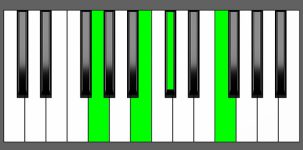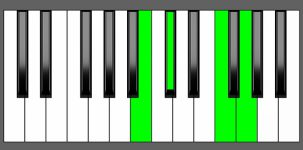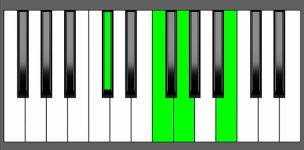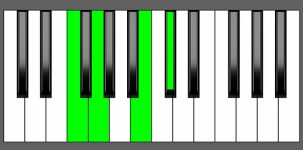Piano Diagram of G7b5 in Root Position
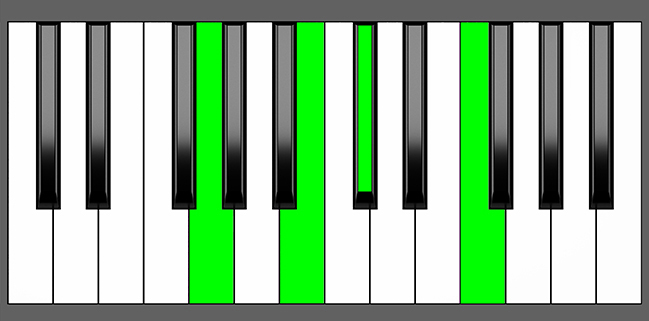
Structure of G7b5
Notes |
|---|
| G, B, Db, F |
Intervals |
|---|
| R, 3, d5, m7 |
Fingers Position
Left Hand |
|---|
| 5, 3, 2, 1 |
Right Hand |
|---|
| 1, 2, 3, 5 |
How to play a G7b5
Play the root note G with your left hand. Then, with your right hand, play the notes F (minor 7th), B (major 3rd), and Db (diminished 5th).
G + F, B, Db
Omitting the root on your right hand, you can play also one of the three inversions of the chord.
G7b5 Chord Inversions
The G7b5 chord has a total of 3 inversions:
| Root Position: | G | B | Db | F |
| 1st Inversion: | B | Db | F | G |
| 2nd Inversion: | Db | F | G | B |
| 3rd Inversion: | F | G | B | Db |
Piano Keyboard Diagrams
G7b5 Chord Equivalencies
If you take a 7b5 chord, you can find another 7b5 chord that has the same notes in it by either going up three steps from the root note or going down three steps from the root note.
For example, G is the root note of G7b5 (G, B, Db, F), so if you go up three steps from G, you get to C#. Therefore, C#7b5 (C#, E#, G, B) has the same notes as G7b5. The same thing happens going down three steps: you get to a Db.
G7b5 = C#7b5 = Db7b5
The reason why going up three steps or going down three steps leads you to a chord with the same notes is because the interval between the root note and the diminished fifth is called a tritone. This interval is halfway between the octave and divides it into two equal parts. Therefore, going up three steps or going down three steps takes you to the same note that is a tritone away from the starting note.
So, the G7b5 chord is equivalent to both C#7b5 and Db7b5 because they all have the same notes in them, even though they have different names.
Music Theory and Harmony of G7b5
Dominant 7b5 chords are often used as a transitional chords to add an extra layer of tension to a dominant 7th chord and prepare for the resolution to the tonic. The G7b5 chord can substitute or enhance the G7 chord, commonly on the V degree in a minor key, but also on the III degree, and occasionally on other degrees as a secondary dominant chord.
Before examining the most common use of this chord, let’s learn how to build it.
Building the G7b5 Chord: Different Approaches
Starting from the G Major Scale:
To form a 7b5 chord, you combine the root, the major 3rd, the diminished 5th, and the minor 7th from a major scale.


To create a G7b5 chord, apply the formula R, 3, d5, m7 in the following manner:
- Begin with the Root note, G.
- Select the major 3rd interval, which is B.
- Add the 5th interval, which is D then lower it by half step to get the diminished 5th, Db.
- Add the minor 7th interval, F.
By following this simple formula, you can create a 7b5 chord from any major scale.
by Combining Intervals:
One method to create a 7b5 chord is by combining specific intervals – a major 3rd, a major 2nd, and a major 3rd.
3 + 2 + 3 = 7b5 Chords
For example, to build a G7b5 chord:
- we start with the root note G.
- We then add a major 3rd interval, which is four half-steps up from the root, to get B.
- Next, we add a major 2nd interval, which is two half-steps (a whole tone) up from B, to get Db.
- Finally, we add a major 3rd interval, which is four half-steps up from Db, to get F.
Together, these intervals form the G7b5 chord.
How to Use G7b5 in a Chord Progression
The G7b5 can work as a substitute or as a passing chord to a G7 that can be found in major and natural minor scales. However, note that it’s a non-diatonic chord due to the presence of the diminished 5th.
These tables show the harmonized major and natural minor scales where you can find a G7 or use it in place of other chords.
Most common uses of G7b5
G7b5 in C Major and C minor
The G7b5 chord is commonly used as a dominant chord. In the key of C major, the G7b5 chord can be used as the V7 chord, which leads back to the I chord (C major).
| Major Scale | I | ii | iii | IV | V | vi | vii |
|---|---|---|---|---|---|---|---|
| C | C Maj7 | D min7 | E min7 | F Maj7 | G7 ⇒ G7b5 | A min7 | Bm7b5 |
- Substitute or Passing Chord to the Dominant chord in C Major.
G7b5 as Substitute for Gm7
The G7 chord derived from the harmonic minor scale is commonly used to replace a Gm7 chord in the key of C minor. In some cases, the G7b5 chord can also be used instead of the G7 chord.
| Natural Minor | i | ii | III | iv | v | VI | VII |
|---|---|---|---|---|---|---|---|
| C | C min7 | Dm7b5 | Eb Maj7 | F min7 | Gm7 ⇒ G7 ⇒ G7b5 | Ab Maj7 | Bb7 |
- Substitute or Passing Chord to the Dominant chord in C minor.
G7b5 in a I – III7 Progression
The G7b5 chord can serve as a substitute for the III chord in a I-III7 chord progression that typically features a G minor chord. In the chord progression represented by the chords Eb Maj7 and G7, the G7b5 chord can replace the expected G minor chord.
| Major Scale | I | ii | iii | IV | V | vi | vii |
|---|---|---|---|---|---|---|---|
| Eb | Eb Maj7 | F min7 | Gm7 ⇒ G7 ⇒ G7b5 | Ab Maj7 | Bb7 | C min7 | Dm7b5 |
- Substitute or Passing Chord to the Mediant chord in Eb Major.
G7b5 in A minor
The G7b5 chord in the A minor scale could function as a leading tone chord, resolving to the A minor chord.
| Natural Minor | i | ii | III | iv | v | VI | VII |
|---|---|---|---|---|---|---|---|
| A | A min7 | Bm7b5 | C Maj7 | D min7 | E min7 | F Maj7 | G7 ⇒ G7b5 |
- Substitute or Passing Chord to the Leading Tone chord in A minor.
G7b5 as Substitute for a Secondary Dominant 7th chord
A secondary dominant is a chord that doesn’t belong to the main key of a song. Instead, it’s used to create a strong pull or tension toward a different chord that does belong to the main key. In Western music, the fifth note of the scale is known for its dominant function, creating tension that typically resolves to the first note of the scale. A secondary dominant serves a similar purpose but directs that tension towards a different chord, briefly taking the music away from the main key.
As an example, in the key of F major, the C7 chord (which is the V chord) naturally leads back to F Maj7. Now, if you insert an additional chord between F Maj7 and C7, and this new chord strongly pulls toward C7, it becomes a secondary dominant chord. For instance, if you introduce a G7 chord in this sequence, it creates that pull toward C7 because G7 is the V chord in the key of C.
| F Maj7 | C7 |
⇒
| F Maj7 | G7 | C7 | F Maj7 |
To spice up a harmonic progression, you can switch out or combine the standard G7 chord with the G7b5 chord. This alteration or inclusion can bring in more tension and complexity to the progression.
| F Maj7 | C7 | F Maj7 |
⇒
| F Maj7 | G7/G7b5 | C7 | F Maj7 |
G7b5 Chord in Major and minor Keys
G7b5 as Dominant Chord in C Major
In the key of C major, the G7 chord serves as the dominant chord. However, you can opt to use the G7b5 chord instead of or in combination with the G7 chord. Here’s how you can approach it:
| I | ii | iii | IV | V | vi | vii |
| C Maj7 | D min7 | E min7 | F Maj7 | G7 | A min7 | Bm7b5 |
G7b5 Chord Progressions as V degree
To get a better understanding of how G7b5 works alongside the dominant chord, try playing these chord progressions. Start by playing a G7b5 chord for half a measure, followed by a G7 chord. This descending tension creates a pleasing sound, especially in the context of the C Major key.
ii V I
| ii | V | I |
| D min7 | G7b5 | G7
G (F, B, Db) | G (F, B, D) |
C Maj7 |
I IV V
| I | IV | V |
| C Maj7 | F Maj7 | G7b5 | G7 |
I V vi IV
| I | V | vi | IV |
| C Maj7 | G7b5 | G7 | A min7 | F Maj7 |
I IV vi V
| I | IV | vi | V |
| C Maj7 | F Maj7 | A min 7 | G7b5 | G7 |
I IV ii V iii vi ii V
| I | IV | ii | V | iii | vi | ii | V |
| C Maj7 | F Maj7 | D min7 | G7b5 | G7 | E min7 | A min7 | D min7 | G7b5 | G7 |
G7b5 as Dominant Chord in C minor
G7 can be found also on the V degree of the C harmonic and melodic minor scales. It’s very common to use this chord in combination with chords built on the natural minor scale or to substitute it for the Gm7 chord that is present in the natural minor scale. In some contexts, we could use a G7b5 instead of a G7 in this position.
| i | ii | III | iv | v | VI | VII |
| C min7 | Dm7b5 | Eb Maj7 | F min7 | G min7 ⇒ G7 ⇒ G7b5 | Ab Maj7 | Bb7 |
G7b5 as V degree on minor Scale – Chord Progressions
Try playing these chord progressions to get an idea of how G7b5 functions as the subdominant (V degree) in the key of C minor. I recommend playing a G7 chord within the same measure as the G7b5 chord, as it adds a sense of harmonic movement to the progression.
ii V7 i
| ii | V7 | i |
| Dm7b5 | G7b5 | G7 | C min7 |
i iv V7
| i | iv | V7 |
| C min7 | F min7 | G7b5 | G7 |
i iv VI V7
| i | iv | VI | V7 |
| C min7 | F min7 | Ab Maj7 | G7b5 | G7 |
i VI V7 iv
| i | VI | V7 | iv |
| C min7 | Ab Maj7 | G7b5 | G7 | F min7 |
Circle Progression
| i | iv | VII | III | VI | ii | V7 | i |
| C min7 | F min7 | Bb7 | Eb Maj7 | Ab Maj7 | Dm7b5 | G7b5 | G7 | C min7 |
G7b5 as III7 Degree in Eb Major
This is a very common substitution of dominant chords in place of minor chords. In the case of G7, we are in Eb major since the minor chord we are going to substitute is on the iii degree of the scale:
| I | ii | iii | IV | V | vi | vii |
| Eb Maj7 | F min7 | G min7 | Ab Maj7 | Bb7 | C min7 | Dm7b5 |
G7b5 as III7 degree – Chord Progressions
Try playing these chord progressions to get an idea of how G7b5 functions in this position. To understand why this substitution is possible, I suggest checking out some of the posts related to dominant 7th chords. There are different interpretations of this substitution, so it can be helpful to explore them to fully understand its potential use.
I III7 vi
| I | III7 | vi |
| Eb Maj7 | G7b5 | G7 | C min7 |
I III7 VI7 ii
| I | III7 | VI7 | ii |
| Eb Maj7 | G7b5 | G7 | C7 | F min7 |
I III7 IV VI7 ii V iii/biiiø ii/V
| I | III7 | IV | VI7 | ii | V | iii/biiiø | ii/V |
| Eb Maj7 | G7b5 | G7 | Ab Maj7 | C7 | F min7 | Bb7 | G min7 | F# dim | F min7 | Bb7 |
“All of me” Progression
| I | III7 | VI7 | ii | III7 | vi | II7 | ii/V |
| Eb Maj7 | G7b5 | G7 | C7 | F min7 | G7 | C min7 | F7 | F min7 | Bb7 |
G7b5 as Leading Tone Chord in A minor
In the key of A minor, the G7 chord is built on the leading tone, which is the seventh note of the scale. This chord can be replaced or modulated by a G7b5.
| i | ii | III | iv | v | VI | VII |
| A min7 | Bm7b5 | C Maj7 | D min7 | E min7 | F Maj7 | G7 |
G7b5 as VII degree – Chord Progressions
i iv VII i
| i | iv | VII | i |
| A min7 | D min7 | G7b5 | G7 | A min7 |
i VII VI V
| i | VII | VI | v |
| A min7 | G7b5 | G7 | F Maj7 | E min7 |
i III VII VI
| i | III | VII | VI |
| A min7 | C Maj7 | G7b5 | G7 | F Maj7 |
i iv VII VI
| i | iv | VII | VI |
| A min7 | D min7 | G7b5 | G7 | F Maj7 |
i iv VII III
| i | iv | VII | III |
| A min7 | D min7 | G7b5 | G7 | C Maj7 |
Circle Progression
| i | iv | VII | III | VI | ii | V7 | i |
| A min7 | D min7 | G7b5 | G7 | C Maj7 | F Maj7 | Bm7b5 | E7 | A min7 |
Alternative G7b5 Nomenclature
- G 7b5
- Sol 7b5
- G 7(-5)
- G 7/b5
- G 7(b5)
- G 7b5th
- G 7 Flat 5
- G Dominant 7th b5
- G Dominant Seventh Flat Fifth
Conclusion
The chord progressions and examples presented in this post provide a comprehensive overview of the most common uses of the G7b5 chord. It’s important to note, however, that many advanced harmony-related topics could not be included due to space constraints. These topics include chord progressions built on harmonic and melodic scales, modal scales, hidden tonality, secondary dominants and other chord substitutions, non-functional harmony and atonal music, modal interchange and borrowed chords, voice leading and counterpoint, chromatisms, jazz harmony…I mean, music theory is a huge topic!
Although I couldn’t cover all of these topics in my post, I encourage readers to continue exploring these areas in their own study and research. By expanding your knowledge in these advanced areas of music theory, you can gain a deeper understanding of the harmonic possibilities that exist beyond the basics presented here.
